"Morning mood"
Nombre total de pages vues
31/07/2018
Science-Presse - Cancer : contourner les résistances à la chimiothérapie - Médecine/Santé
 Efficace sur les cellules malignes qui prolifèrent rapidement, la chimiothérapie rencontre néanmoins des obstacles. Certaines personnes développent une résistance au traitement : les médicaments ne parviennent plus à détruire leurs cellules cancéreuses.
Efficace sur les cellules malignes qui prolifèrent rapidement, la chimiothérapie rencontre néanmoins des obstacles. Certaines personnes développent une résistance au traitement : les médicaments ne parviennent plus à détruire leurs cellules cancéreuses.
Une équipe québécoise a récemment identifié un nouveau mécanisme moléculaire expliquant cette résistance aux médicaments anticancéreux. Mieux, leur étude montre que ces chercheurs ont réussi à contourner les résistances en rendant les tumeurs à nouveau sensibles à la chimiothérapie.
« La découverte de ce nouveau mécanisme de résistance est prometteuse et nous avons déjà une piste pour le diminuer », explique Claire Dubois, chercheuse en immunologie à l’Université de Sherbrooke.
C’est l’augmentation du taux d’acidité au sein de la tumeur qui développe ce mécanisme de défense contre les médicaments — et dans certaines circonstances, le développe tant et si bien que le médicament devient inefficace. Cela se produit dans un micro-environnement pauvre en oxygène (hypoxie), qui est une caractéristique du développement des cellules malades.
L’équipe de Claire Dubois s’est donc intéressée à ces changements de pH et à l’appauvrissement en oxygène. Une cellule qui pousse dans un environnement aussi hostile doit nécessairement s’adapter — ce que les cellules normales ne parviennent pas à faire, au contraire des « super cellules » cancéreuses.
L’impact de l’hypoxie sur l’invasion des cellules cancéreuses était déjà connu. « Les régions pauvres en oxygène génèrent des structures aberrantes sur les vaisseaux sanguins — les nouvelles vascularisations se forment mal — et augmentent la malignité des tumeurs », rappelle la chercheuse.
En modifiant ainsi leur environnement, les cellules cancéreuses parviennent donc à résister aux médicaments en sur-acidifiant certains de leurs « compartiments » — ou endosomes. En devenant très acides et pauvres en oxygène, elles vont y piéger les molécules du médicament.
Lire l'article complet sur :
http://www.sciencepresse
http://www.sciencepresse
ESA/DLR/FU Berlin; Bill Dunford - Layers of the South Pole of Mars - Astronomy picture of the day - 2018 July 31
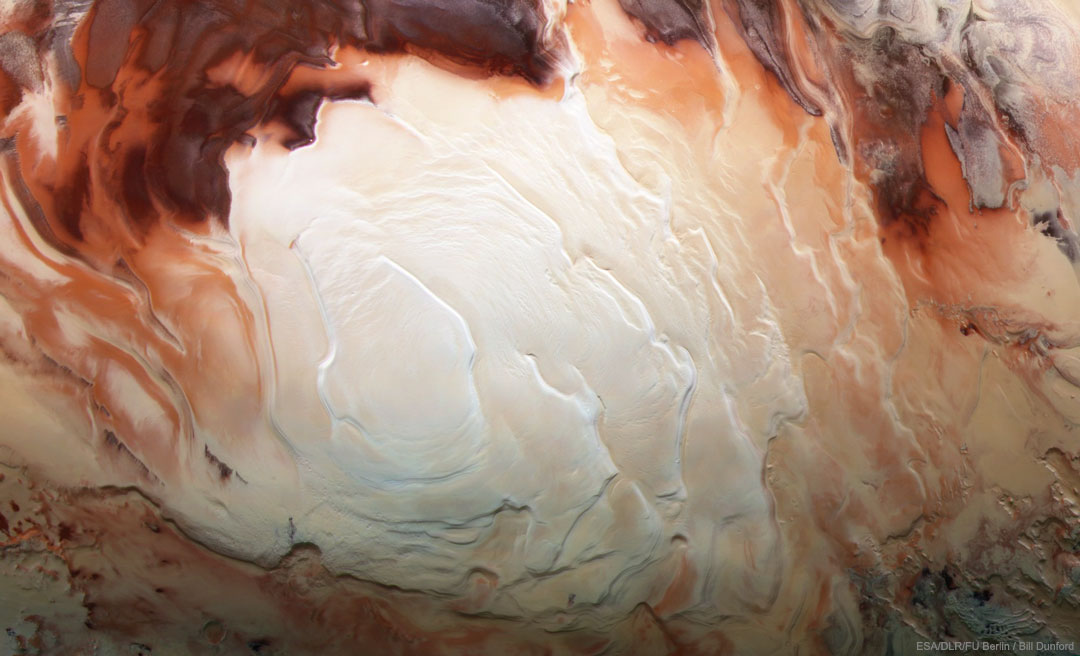
Image Credit & License: ESA/DLR/FU Berlin; Bill Dunford
Explanation: What lies beneath the layered south pole of Mars? A recent measurement with ground-penetrating radar from ESA's Mars Express satellite has detected a bright reflection layer consistent with an underground lake ofsalty water. The reflection comes from about 1.5-km down but covers an area 200-km across. Liquid water evaporates quickly from the surface of Mars, but a briny confined lake, such as implied by the radar reflection, could last much longer and be a candidate to host life such as microbes. Pictured, an infrared, green, and blue image of the south pole of Mars taken by Mars Express in 2012 shows a complex mixture of layers of dirt, frozen carbon dioxide, andfrozen water.
30/07/2018
Carlos 'Kiko' Fairbairn - Lunar Eclipse over Rio - Astronomy picture of the day - 2018 July 30
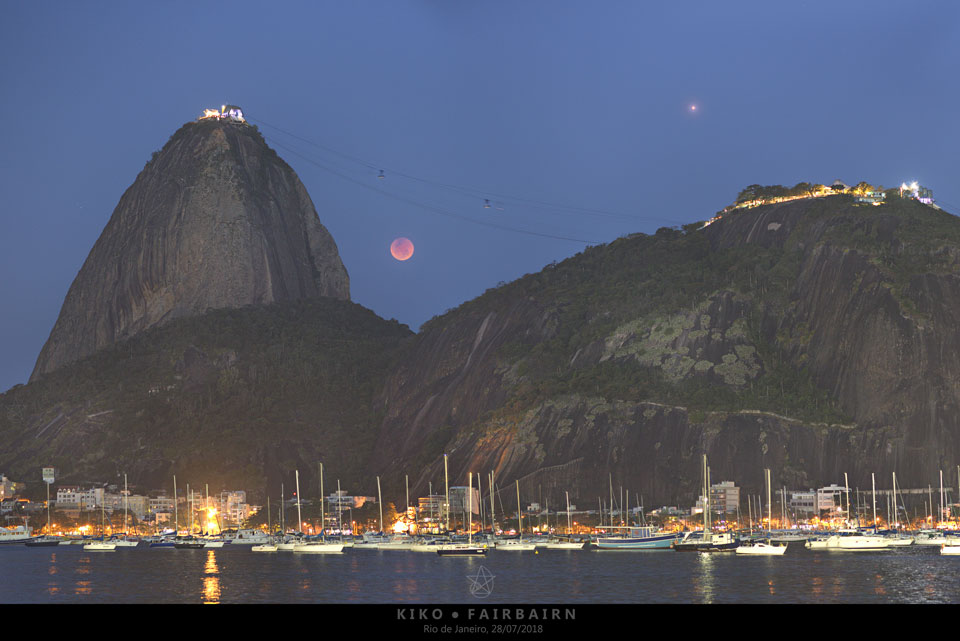
Image Credit: Carlos 'Kiko' Fairbairn
Explanation: Moonrise doesn't usually look this interesting. For one thing, the full moon is not usually this dark -- but last Friday the moon rose here as it simultaneously passed through the shadow of the Earth. For another thing, the Moon does not usually look this red -- but last Friday it was slightly illuminated by red sunlight preferentially refracted through the Earth's atmosphere. Next, the Moon doesn't usually rise next to a planet, but since Mars was also coincidently nearly opposite the Sun, the red planet was visible to the full moon's upper right. Finally, from the vantage point of most people, the Moon does not usually rise over Rio de Janeiro in Brazil. Last Friday's sunset eclipse, however, specifically its remarkable Micro Blood Moon Total Lunar Eclipse, was captured from Rio's Botofogo Beach, along with an unusually large crowd of interested onlookers.
29/07/2018
Usine Nouvelle - Le Beluga XL barbote enfin dans le ciel - Aeronautique

Le dernier-né de la famille Airbus, le premier BelugaXL, nouvel avion-cargo de l'avionneur européen, a réussi ce jeudi 19 juillet son décollage, à partir des pistes de Toulouse-Blagnac (Haute-Garonne), pour un premier vol d'essai d'une durée d'environ quatre heures.
Un événement fêté comme il se doit, dans la tradition d'Airbus, en présence de plusieurs centaines de salariés du groupe, de partenaires industriels et d'élus locaux. D'autant que ce nouveau programme s'inscrit directement dans l'organisation industrielle de l'avionneur européen.
Ce nouvel avion-cargo, successeur de l'actuel BelugaST (mis en service en 1994), doit accompagner les montées en cadences de production de l'A350 XWB et des avions mono-couloirs d'Airbus. Sa mission est d'assurer, comme pour son prédécesseur, le transport d'ailes et de tronçons entiers de fuselage entre les différents sites industriels d'Airbus en Europe. "C'est une pièce maîtresse dans l'organisation industrielle du groupe", insiste Bertrand George, directeur du programme chez Airbus.
ESO/MPE/Nick Risinger (skysurvey.org)/VISTA/J. Emerson/Digitized Sky Survey 2 - Journey to the Center of the Galaxy - Astronomy picture of the day - 2018 july 29
Video Credit: ESO/MPE/Nick Risinger (skysurvey.org)/VISTA/J. Emerson/Digitized Sky Survey 2
Explanation: What wonders lie at the center of our Galaxy? In Jules Verne's science fiction classic A Journey to the Center of the Earth, Professor Liedenbrock and his fellow explorers encounter many strange and exciting wonders. Astronomers already know of some of the bizarre objects that exist at our Galactic center, including like vast cosmic dust clouds, bright star clusters, swirling rings of gas, and even a supermassive black hole. Much of the Galactic Center is shielded from our view in visible light by the intervening dust and gas, but it can be explored using other forms of electromagnetic radiation. The featured video is actually a digital zoom into the Milky Way's center which starts by utilizing visible light images from the Digitized Sky Survey. As the movie proceeds, the light shown shifts to dust-penetrating infrared and highlights gas clouds that were recently discovered in 2013 to be falling toward central black hole. In 2018 May, observations of a star passing near the Milky Way's central black hole showed, for the first time, a gravitational redshift of the star's light -- as expected from Einstein's general relativity.
28/07/2018
Fernando Cabrerizo (Centro Astronomico de Tiedra) - One Night, One Telescope, One Camera - Astronomy picture of the day - 2018 July 28
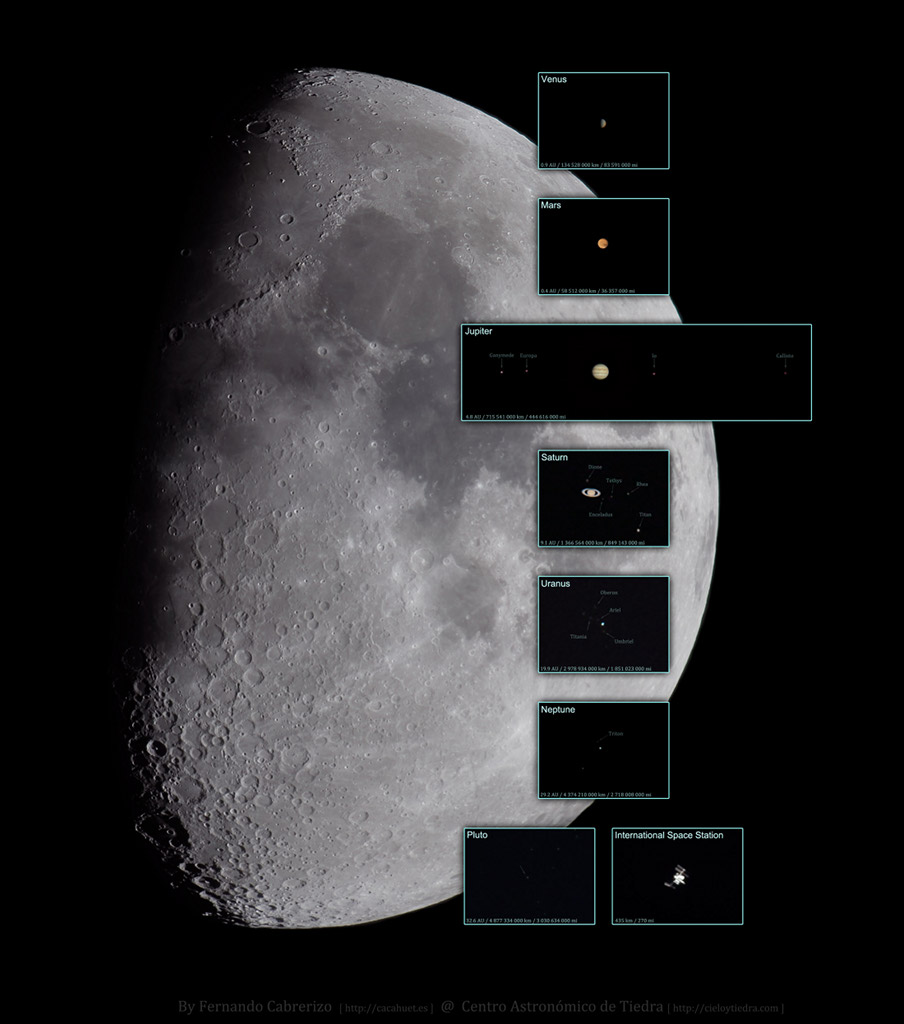
Image Credit & Copyright: Fernando Cabrerizo (Centro Astronomico de Tiedra)
Explanation: Taken on the same night, from the same place, with the same telescope and camera, these postcards from our Solar System are shown at the same scale to provide an interesting comparison of apparent sizes. Spanning about half a degree in planet Earth's sky, the Moon is a stitched mosaic of six images. The others are the result of digitally stacked frames or simple single exposures, with the real distances to the objects indicated along the bottom of each insert. Most of the Solar System's planets with their brighter moons, and Pluto were captured during the telescopic expedition, but elusive Mercury was missed because of clouds near the horizon. The International Space Stationwas successfully hunted, though. The night was July 21st. Telescope and camera were located at the Centro Astronomico de Tiedra Observatory in Spain.
NASA, ESA, and STScI - Mars Opposition - Astronomy picture of the day - 2018 July 27
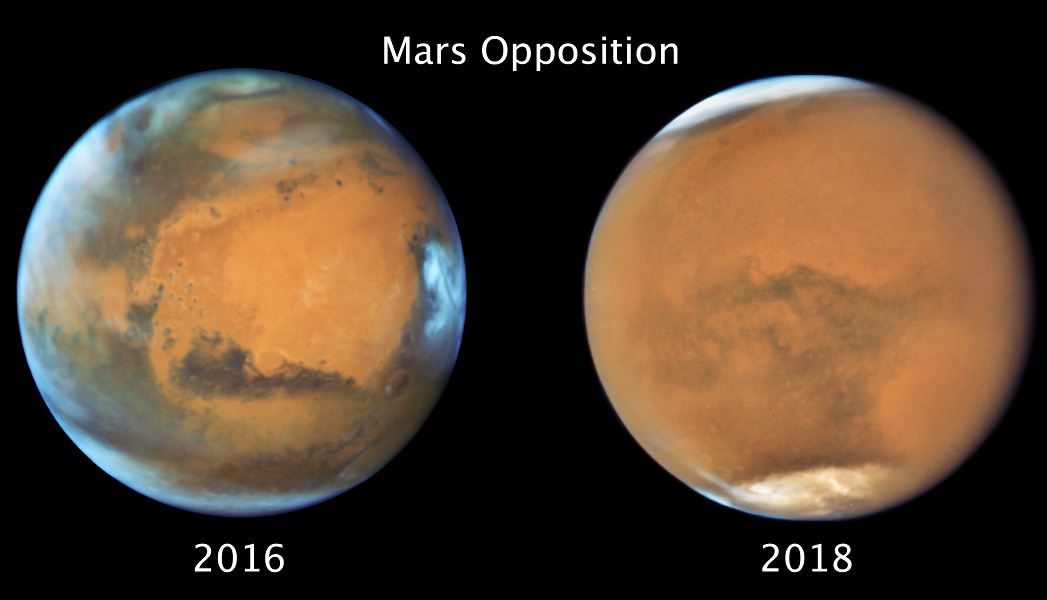
Image Credit & Copyright: NASA, ESA, and STScI
Explanation: Look opposite the Sun in the sky tonight and you'll see Mars at its brightest. Also within days of its closest approach Mars rises at sunset, near its brightest and best for telescopic observers too, except for the dust storm still blanketing the Red Planet. These two Hubble Space Telescope images compare Mars' appearance near its 2016 and 2018 oppositions. In 2016 the martian atmosphere was clear. Captured just days ago, the 2018 image shows almost the same face of Mars. Surface features obscured by dust, the planet's cloud enshrouded south pole is tilted more toward the Sun. Increased heat in the southern hemisphere spring and summer likely triggers planet wide dust storms. Of course, if you look opposite the Sun in the sky tonight, you'll also see a Full Moon near Mars. Skygazers NOT located in North America could see the Red Planet near a Red Moon during a Total Lunar Eclipse.
26/07/2018
Gabriel Rodrigues Santos - Barnard 228: The Dark Wolf Nebula in Lupus - Astronomy picture of the day - 2018 July 26
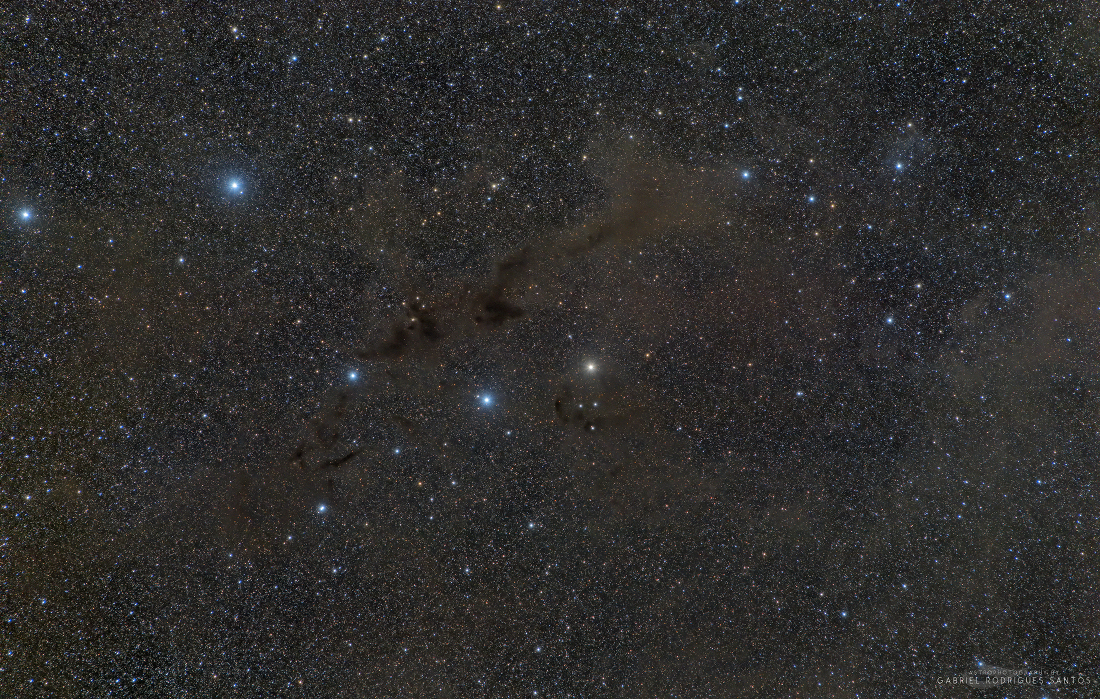
Image Credit & Copyright: Gabriel Rodrigues Santos
Explanation: These dark markings on the sky can just be found in silhouette against a rich, luminous background of stars. Seen toward the southern constellation of Lupus the Wolf, the dusty, obscuring clouds are part of the Lupus Molecular Cloud some 500 light-years distant. Packs of low mass stars are forming within them, from collapsing cores only visible at long infrared wavelengths. Still, colorful stars in Lupus add to this pretty galactic skyscape. It spans about 8 degrees, not far from the central Milky Way.
25/07/2018
Adam Block, Mt. Lemmon SkyCenter, U. Arizona - The Edge-On Spindle Galaxy - Astronomy picture of the day - 2018 July 25
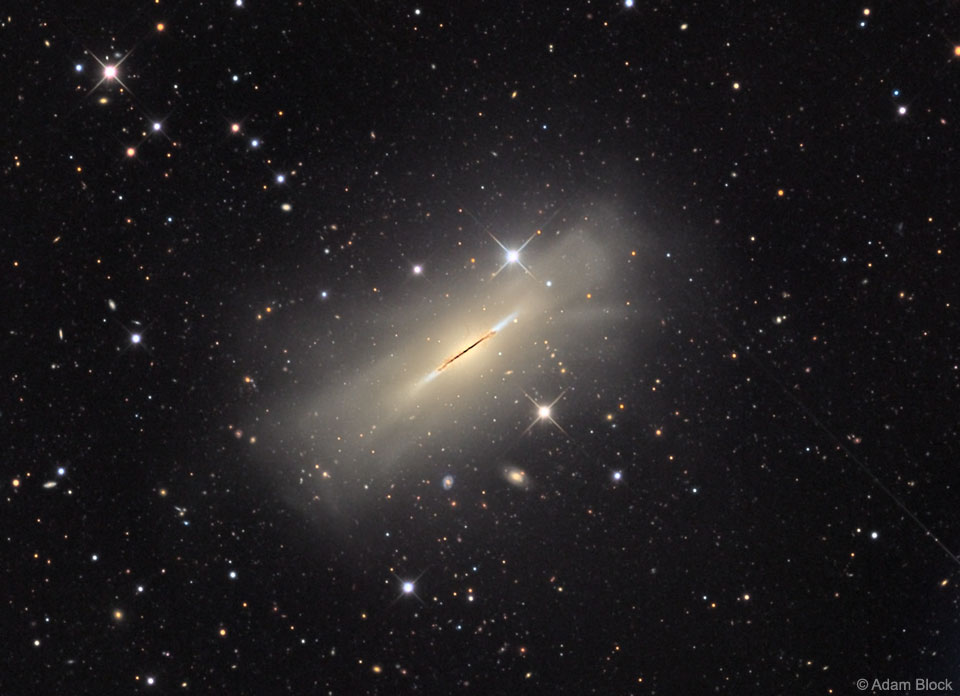
Image Credit & Copyright: Adam Block, Mt. Lemmon SkyCenter, U. Arizona
Explanation: What kind of celestial object is this? A relatively normal galaxy -- but seen from its edge. Many disk galaxies are actually just as thin as NGC 5866, pictured here, but are not seen edge-on from our vantage point. A perhaps more familiar galaxy seen edge-on is our own Milky Way Galaxy. Cataloged as M102 and NGC 5866, the Spindle galaxy has numerous and complex dust lanes appearing dark and red, while many of the bright stars in the disk give it a more blue underlying hue. The blue disk of young stars can be seen extending past the dust in the extremely thin galactic plane. There is evidence that the Spindle galaxy has cannibalized smaller galaxies over the past billion years or so, including multiple streams of faint stars, dark dust that extends away from the main galactic plane, and a surrounding group of galaxies (not shown). In general, many disk galaxies become thin because the gas thatforms them collides with itself as it rotates about the gravitational center. The Spindle galaxy lies about 50 million light years distant toward the constellation of the Dragon (Draco).
24/07/2018
Angelo Perrone - Clouds of Earth and Sky - Astronomy picture of the day - 2018 July 24
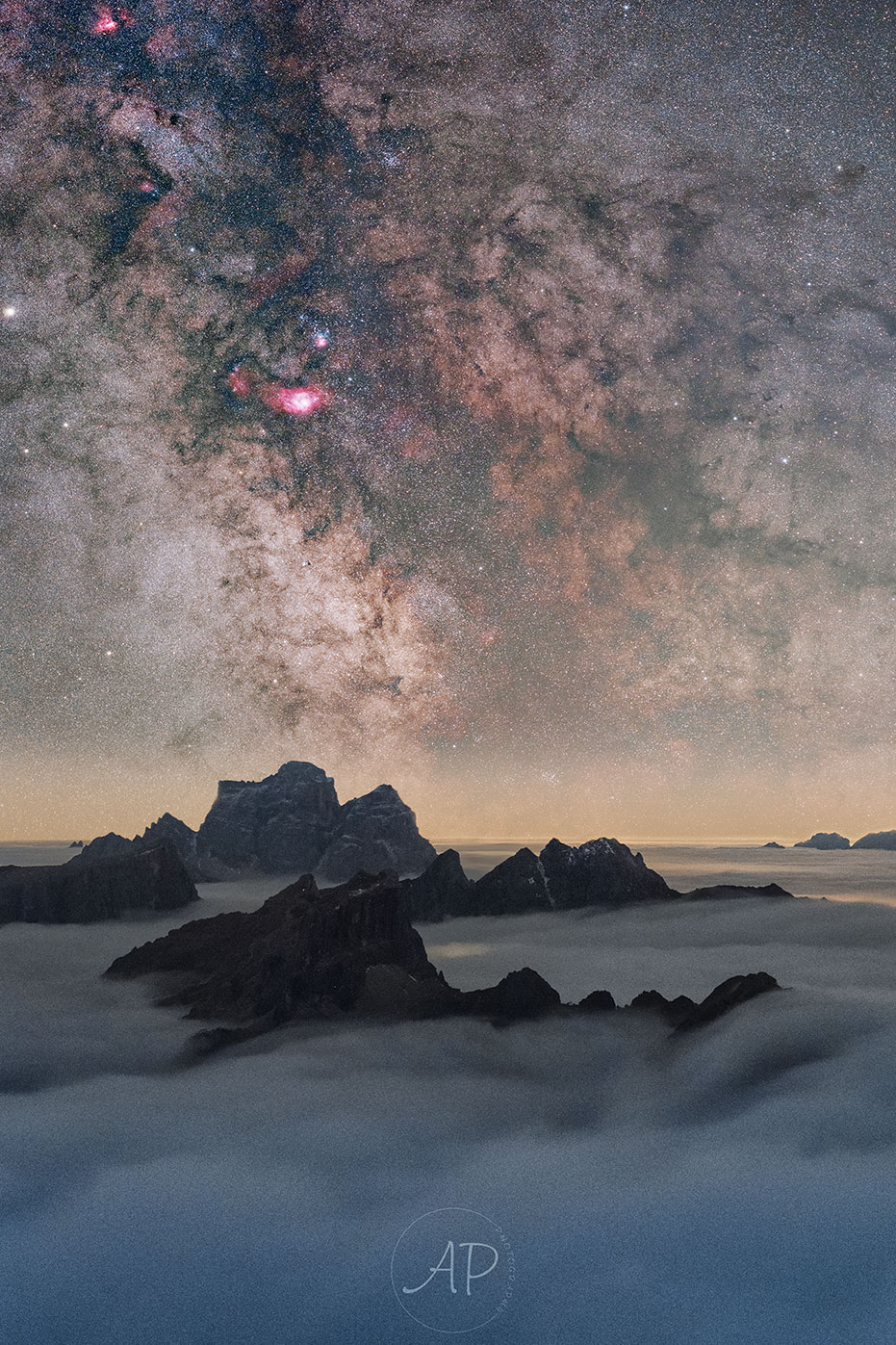
Image Credit & Copyright: Angelo Perrone
Explanation: If you go high enough, you may find yourself on a picturesque perch between the water clouds of the Earth and the star clouds of the Milky Way. Such was the case last month for one adventurous alpinist astrophotographer. Captured here in the foreground above white clouds are mountain peaks in the Dolomite range in northern Italy. This multi-exposure image was captured from Lagazuoi, one of the Dolomites. Hundreds of millions of years ago, the Dolomites were not mountains but islands an ancient sea that rose through colliding tectonic plates. The Dolomites divergent history accounts for its unusually contrasting features, which include jagged crests and ancient marine fossils. High above even the Dolomites, and far in the distance, dark dust lanes streak out from the central plane of our Milky Way Galaxy. The stars and dust are dotted with bright red clouds of glowing hydrogen gas -- such as the Lagoon Nebula just above and to the left of center.
23/07/2018
NASA, DOE, International Fermi LAT Collaboration - Fermi Science Finals - Astronomy picture of the day - 2018 July 23
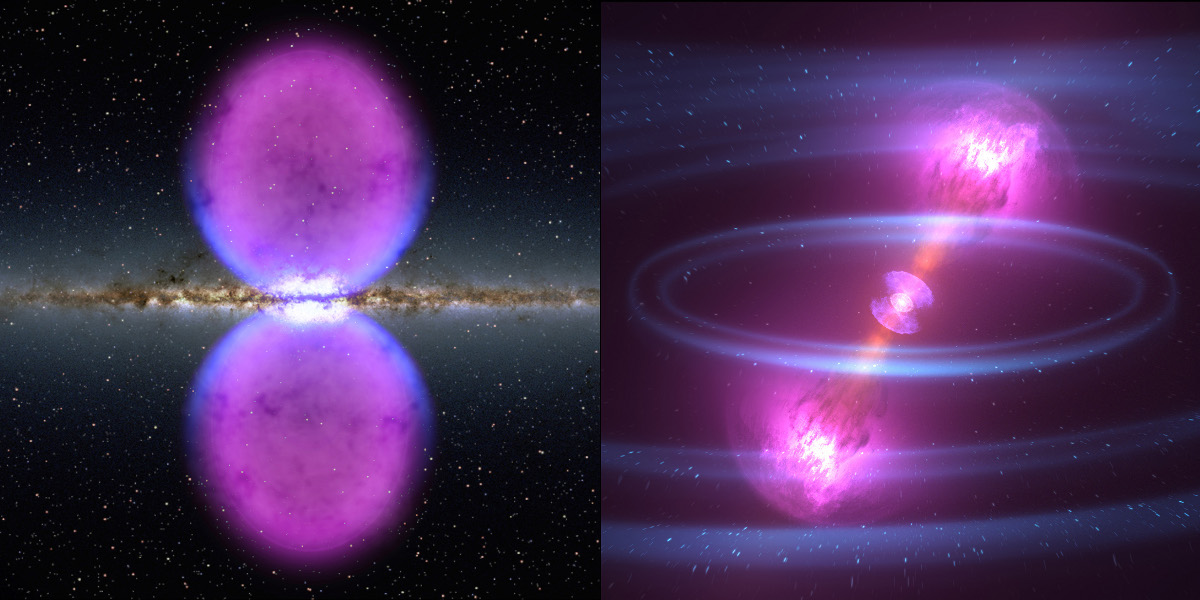
Illustration Credit: NASA, DOE, International Fermi LAT Collaboration, Jay Friedlander (Goddard Space Flight Center)
Explanation: The Fermi Science Playoffs celebrate 10 years of the Fermi Gamma-ray Space Telescope's exploration of the high-energy universe. Surviving all early rounds of voting, these two finalists in the competion square off at last. Digital illustrations from a list of 16 of Fermi's top scientific discoveries, they represent the competition's two top seeds, defeating 12th seed New Clues to Dark Matter and 14th seed Starquakes in Magnetar Storm in the semifinal round. On the left are unprecedented, unpredicted, 25,000 light-year tall Gamma-ray Bubbles above and below the plane of our Milky Way galaxy. On the right, violently merging Neutron Stars Collide to create the first gamma-ray detected gravitational wave event. Pick one now and cast your vote here to crown the most popular science result from Fermi's first decade.
22/07/2018
Hubble, NASA, ESA - Symbiotic R Aquarii - Astronomy picture of the day - 2018 July 22

Image Credit: Hubble, NASA, ESA; Processing & License: Judy Schmidt
Explanation: You can see it change in brightness with just binoculars over the course of a year. Variable star R Aquarii is actually an interacting binary star system, two stars that seem to have a close, symbiotic relationship. About 710 light years away, this intriguing system consists of a cool red giant star and hot, dense white dwarf star in mutual orbit around their common center of mass. The binary system's visible light is dominated by the red giant, itself a Mira-type long period variable star. But material in the cool giant star's extended envelope is pulled by gravity onto the surface of the smaller, denser white dwarf, eventually triggering a thermonuclear explosion and blasting material into space. Thefeatured image from the Hubble Space Telescope shows the still-expanding ring of debris which spans less than a light year and originated from a blast that would have been seen in the early 1770s. The evolution of less understood energetic events producing high energy emission in the R Aquarii system has been monitored since 2000 using Chandra X-ray Observatory data.
21/07/2018
Neil Armstrong, Apollo 11, NASA - Apollo 11 Landing Site Panorama - Astronomy picture of the day - 2018 July 21
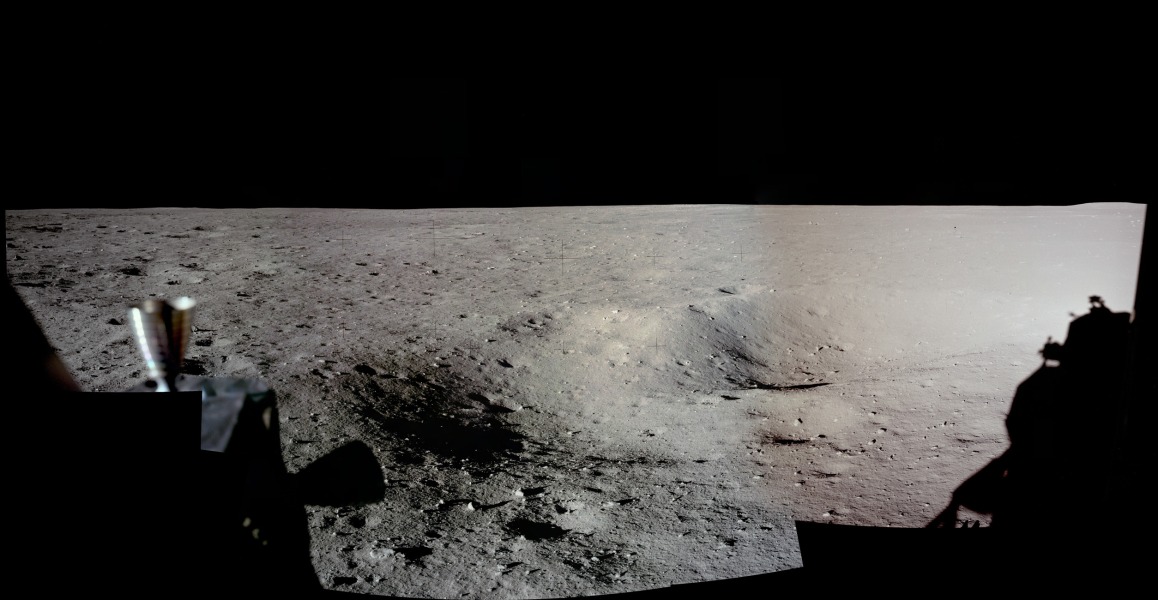
Image Credit: Neil Armstrong, Apollo 11, NASA
Explanation: Have you seen a panorama from another world lately? Assembled from high-resolution scans of the original film frames, this one sweeps across the magnificent desolation of the Apollo 11 landing site on the Moon's Sea of Tranquility. The images were taken by Neil Armstrong looking out his window of the Eagle Lunar Module shortly after the July 20, 1969 landing. The frame at the far left (AS11-37-5449) is the first picture taken by a person on another world. Toward the south, thruster nozzles can be seen in the foreground on the left, while at the right, the shadow of the Eagle is visible to the west. For scale, the large, shallow crater on the right has a diameter of about 12 meters. Frames taken from the Lunar Module windows about an hour and a half after landing, before walking on the lunar surface, were intended to initially document the landing site in case an early departure was necessary.
20/07/2018
Le Cosmographe - Eclipse de Lune et planètes à l'oeil nu - Video - Espace
Tous les curieux du ciel, et bien sûr les astronomes amateurs, sont gâtés pour ce mois de juillet : quasiment toutes les planètes du Système solaire sont visibles au cours des douces nuits de l’été. Cinq le sont à l’œil nu. S’y ajoute l’astéroïde Vesta. Mais il n’y a pas que ça ! Événement céleste à ne pas rater : la plus longue éclipse de Lune du siècle le même jour que l’opposition de Mars ! Et en plus, ce sera la plus petite distance entre la Terre et la Planète rouge depuis 2003 ! Un beau festival de planètes.
Ce mois de juillet 2018 va combler tous les observateurs du ciel, que vous soyez simple curieux ou astronome amateur chevronné. C’est en effet un vrai défilé de planètes, du crépuscule à l’aube. Un paradis pour tous les amateurs de planètes qui souhaitent les contempler ou les photographier. Et ce n’est pas tout : la Lune se donnera en spectacle à la fin du mois pour une longue éclipse. Cerise sur la gâteau, la planète rouge sera alors visible à côté d’elle, le jour de son opposition (le 27 juillet). Et cette année, c’est un grand cru.
Notre satellite naturel a rendez-vous avec toutes ces planètes au fil de sa lunaison. Les 5 visibles à l’œil nu, auxquelles s’ajoutent les lointaines Uranus et Neptune et l’astéroïde Vesta, le deuxième plus gros corps de la Ceinture d’astéroïdes. Alors, si d’aventure vous hésitiez encore à acheter uninstrument d’observation — et/ou du matériel pour photographier le ciel —, ce mois de juillet (avec les vacances) est peut-être le bon moment. Vous pourrez ainsi admirer au cours des douces nuits d’été, le croissant de Vénus, les bandes colorées de Jupiter (et ses satellites), Saturne et ses anneaux, Vesta… ! Enfin, Pluton, une ex-planète classée maintenant comme planète naine, sera en opposition le 12 juillet. Il y a 3 ans, le 14 juillet 2015, New Horizons réalisait son survol historique de l’astre et de ses compagnons. Des images qu’on n’est pas prêt d’oublier !
Kerry-Ann Lecky Hepburn (Weather and Sky Photography) - The Teapot and the Milky Way - Astronomy picture of the day - 2018 July 20
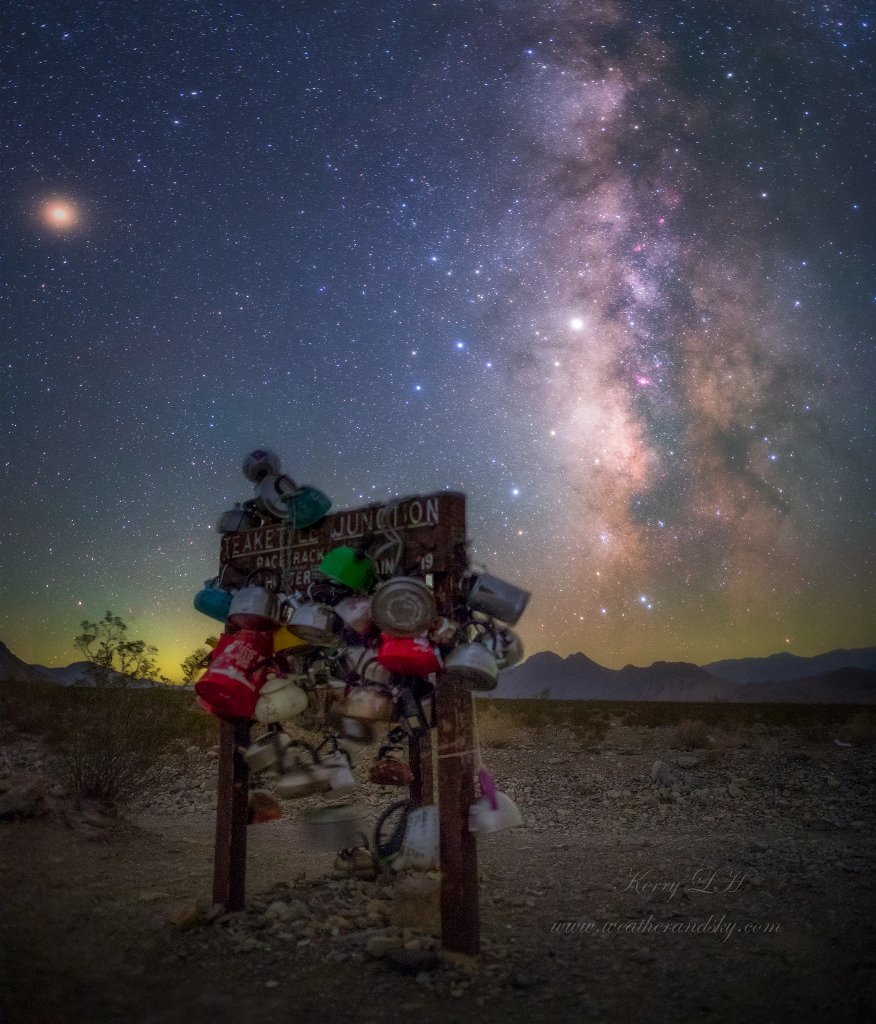
Image Credit & Copyright: Kerry-Ann Lecky Hepburn (Weather and Sky Photography)
Explanation: The recognizable stars of the Teapot asterism in the constellation Sagittarius posed with the Milky Way over Death Valley, planet Earth on this quiet, dark night. The surreal scene was appropriately captured fromTeakettle Junction, marked by the wooden sign adorned with terrestrial teapots and kettles on the rugged road to Racetrack Playa. Shining against the luminous starlight of the central Milky Way is bright planet Saturn, just above the star at the celestial teapot's peak. But the brightest celestial beacon, high above the southern horizon, is an orange tinted Mars at upper left in the frame.
19/07/2018
HiRISE, MRO, LPL (U. Arizona), NASA - Dark Slope Streaks Split on Mars - Astronomy picture of the day - 2018 July 19
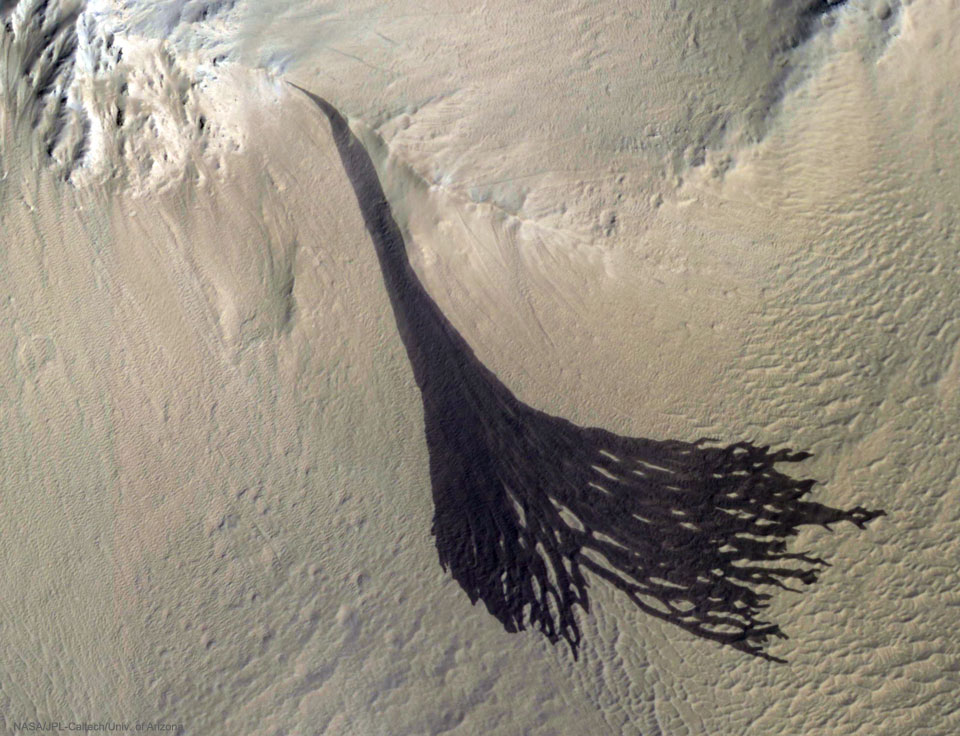
Image Credit: HiRISE, MRO, LPL (U. Arizona), NASA
Explanation: What is creating these dark streaks on Mars? No one is sure. Candidates include dust avalanches, evaporating dry ice sleds, and liquid water flows. What is clear is that the streaks occur through light surface dust and expose a deeper dark layer. Similar streaks have been photographed on Mars for years and are one of the few surface features that change their appearance seasonally. Particularly interesting here is that larger streaks split into smaller streaks further down the slope. The featured image was taken by the HiRISE camera on board the Mars-orbiting Mars Reconnaissance Orbiter (MRO) several months ago. Currently, a global dust storm is encompassing much of Mars.
18/07/2018
James W. Young - Moon and Venus over Cannon Beach - Astronomy picture of the day - 2018 July 18
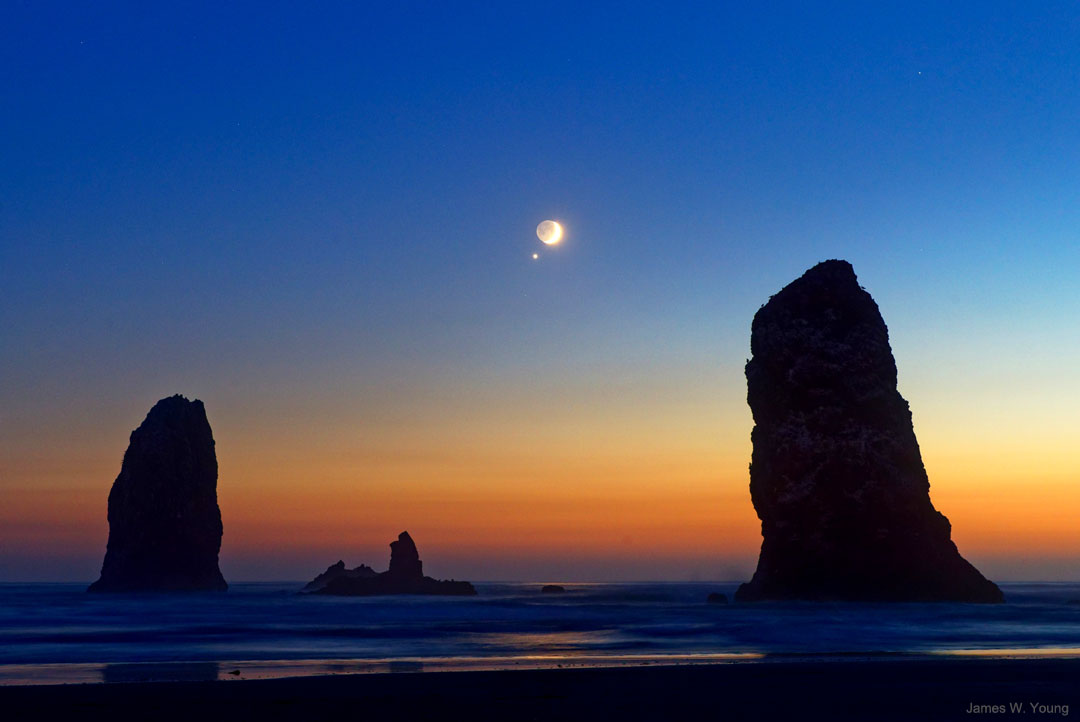
Image Credit & Copyright: James W. Young
Explanation: What's that spot next to the Moon? Venus. Two days ago, the crescent Moon slowly drifted past Venus, appearing within just one degree at its closest. This conjunction, though, was just one of several photographic adventures for our Moon this month (moon-th), because, for one, a partial solar eclipse occurred just a few days before, on July 12. Currently, the Moon appears to be brightening, as seen from the Earth, as the fraction of its face illuminated by the Sun continues to increase. In a few days, the Moon will appear more than half full, and therefore be in its gibbous phase. Next week the face of the Moon that always faces the Earth will become, as viewed from the Earth, completely illuminated by the Sun. Even this full phase will bring an adventure, though, as a total eclipse of this Thunder Moon will occur on July 27. Don't worry about our Luna getting tired, though, because she'll be new again next month (moon-th) -- August 11 to be exact -- just as she causes another partial eclipse of the Sun. Pictured, Venus and the Moon were captured from Cannon Beach above a rock formation off the Oregon (USA) coast known asthe Needles. About an hour after this image was taken, the spin of the Earth caused both Venus and the Moon to set.
17/07/2018
Jornal Sol - Alerta : Temperaturas vão chegar aos 45 graus - (Meteorologia)
 Onda de calor extremo poderá atingir a Península Ibérica entre domingo e quinta-feira da próxima semana.
Onda de calor extremo poderá atingir a Península Ibérica entre domingo e quinta-feira da próxima semana.
As temperaturas poderão chegar aos 45 graus no Centro, no Sul e em zonas do Interior Norte entre o próximo domingo e quinta-feira da semana que vem. A informação está a ser adiantada por sites de meteorologia não oficiais, portugueses e espanhóis. Contactado pelo i, o Instituto Português do Mar e da Atmosfera (IPMA) confirma que o tempo deverá "estabilizar" nos próximos dias, sendo esperadas "temperaturas acima dos 30 graus" a partir da próxima semana, mas avisa que, com seis de antecedência, não é possível prever ondas de calor.
Segundo sites como o MeteoAlerta ou o MeteoBadajoz, está previsto "um episódio de calor muito extremo em todo o Continente" de Portugal, entre domingo, dia 8 de julho, e quinta-feira, dia 12. "Uma depressão em altura vai colocar-se a Oeste do Continente e arrastar uma massa de ar muito quente do Norte de África por toda a Península Ibérica", garantem os especialistas do MeteoAlerta, ressalvando que se a "localização final dessa depressão ficar mais próxima dos Açores" o calor será maior. "Se ficar mais próximo da costa portuguesa, podemos ter um calor mais dentro do normal", acrescentam.
16/07/2018
DESY, Science Communication Lab - Neutrino Associated with Distant Blazar Jet - Astronomy picture of the day - 2018 July 16
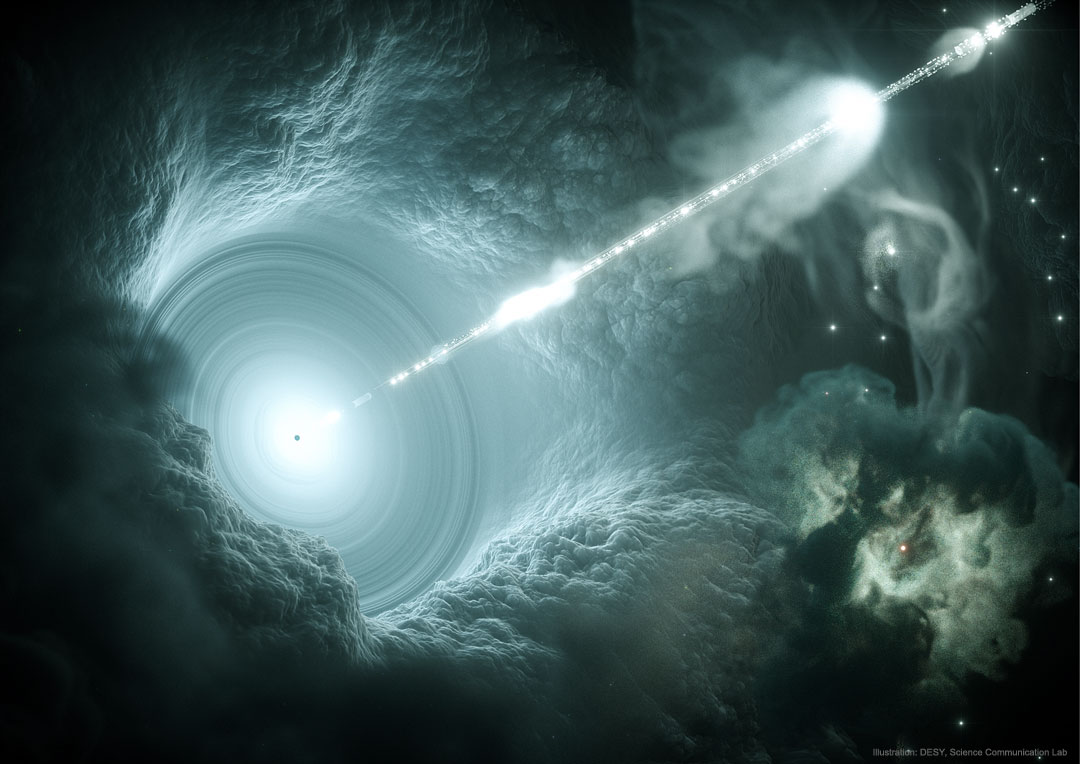
Illustration Credit: DESY, Science Communication Lab
Explanation: With equipment frozen deep into ice beneath Earth's South Pole, humanity appears to have discovered a neutrino from far across the universe. If confirmed, this would mark the first clear detection of cosmologically-distant neutrinos and the dawn of an observed association between energetic neutrinos and cosmic rays created by powerful jets emanating from blazing quasars (blazars). Once the Antarctican IceCube detector measured an energetic neutrino in 2017 September, many of humanity's premier observatories sprang into action to try to identify a counterpart in light. And they did. An erupting counterpart was pinpointed by high energy observatories including AGILE,Fermi, HAWC, H.E.S.S., INTEGRAL, NuSTAR, Swift, and VERITAS, which found that gamma-ray blazar TXS 0506+056 was in the right direction and with gamma-rays from a flare arriving nearly coincidental in time with the neutrino. Even though this and other position and time coincidences are statistically strong, astronomers will await other similar neutrino - blazar light associations to be absolutely sure. Pictured here is an artist's drawing of a particle jetemanating from a black hole at the center of a blazar.
La Tribune - L'Eraole, un avion électrique 100% propre - Aéronautique - Video
 L'Eraole passera-t-il le cap du prototype ? Pour Raphaël Dinelli, créateur de cet avion électrique multi-hybride 100% propre, les trois prochains mois risquent d'être décisifs. Le 14 juillet, il a décollé de l'aérodrome de la Roche-sur-Yon, en Vendée pour une série de tests et de mesures grandeur nature. Suivront Les Sables-d'Olonne, la Rochelle, Bordeaux, Toulouse, Perpignan, puis la Bretagne et les Hauts-de-Seine, aux alentours du 15 août.
L'Eraole passera-t-il le cap du prototype ? Pour Raphaël Dinelli, créateur de cet avion électrique multi-hybride 100% propre, les trois prochains mois risquent d'être décisifs. Le 14 juillet, il a décollé de l'aérodrome de la Roche-sur-Yon, en Vendée pour une série de tests et de mesures grandeur nature. Suivront Les Sables-d'Olonne, la Rochelle, Bordeaux, Toulouse, Perpignan, puis la Bretagne et les Hauts-de-Seine, aux alentours du 15 août.
Contrairement au « Solar Impulse » de Bertrand Piccard, qui fonctionne avec le soleil mais aussi des batteries chargées au sol, l'Eraole s'appuie sur une centrale électrique multi-hybride alimentée par le solaire (25%) via les cellules photovoltaïques qui recouvrent les ailes, de l'huile végétale (70%) pour alimenter un moteur thermique et de l'hydrogène produit en vol par hydrolyse.
« C'est cette chaîne de traction qui est une innovation mondiale. On vole avec une énergie totalement propre, contrairement à des batteries dont l'électricité a pu être fournie par une centrale à charbon ou nucléaire. »
15/07/2018
Robert Gendler - Rings Around the Ring Nebula - Astronomy picture of the day - 2018 July 15
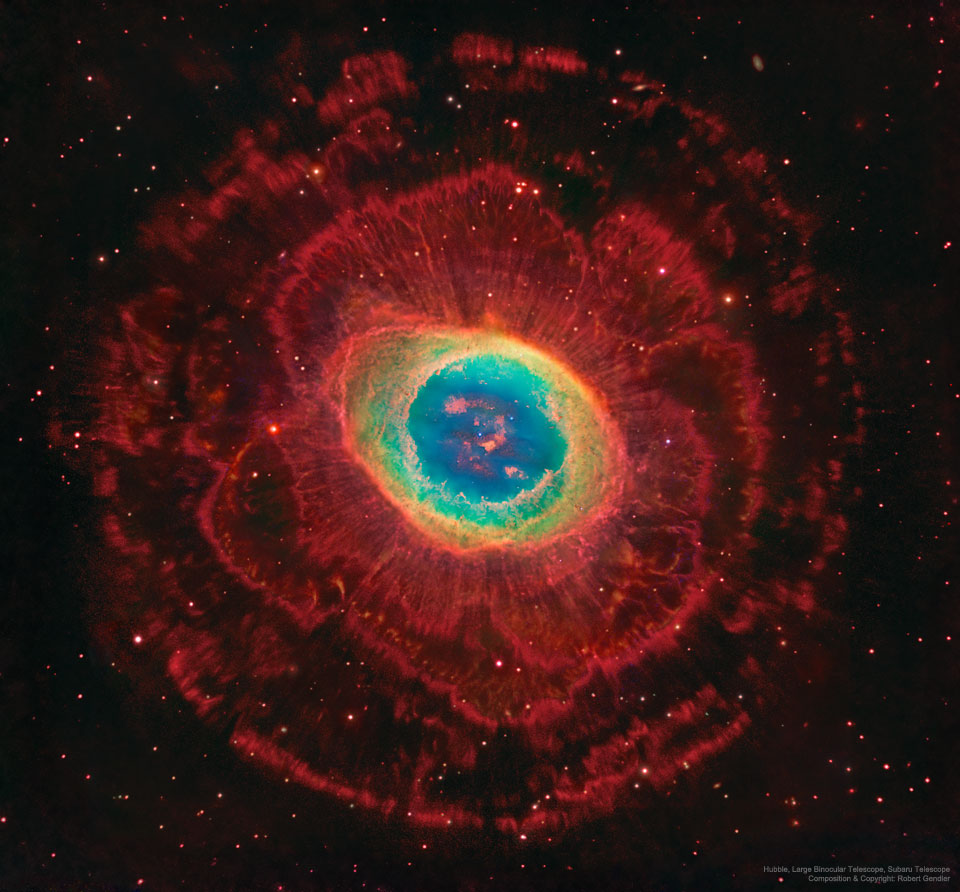
Image Credit: Hubble, Large Binocular Telescope, Subaru Telescope; Composition & Copyright: Robert Gendler
Explanation: There is much more to the familiar Ring Nebula (M57), however, than can be seen through a small telescope. The easily visible central ring is about one light-year across, but this remarkably deep exposure - a collaborative effort combining data from three different large telescopes - explores the looping filaments of glowing gas extending much farther from the nebula's central star. This remarkable composite image includes narrowband hydrogen image, visible light emission, and infrared light emission. Of course, in this well-studied example of a planetary nebula, the glowing material does not come from planets. Instead, the gaseous shroud represents outer layersexpelled from a dying, sun-like star. The Ring Nebula is about 2,000 light-years away toward the musical constellation Lyra.
14/07/2018
Padraic Koen - A Nibble on the Sun - Astronomy picture of the day - 2018 July 14
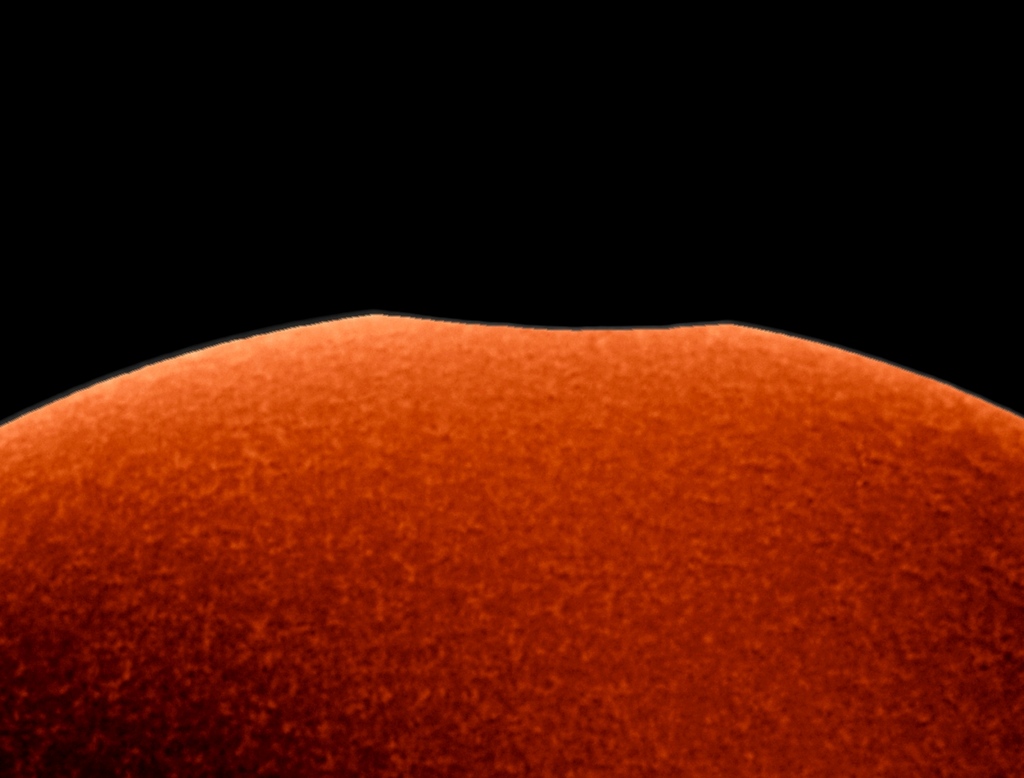
Image Credit & Copyright: Padraic Koen, Adelaide, South Australia
Explanation: The smallest of the three partial solar eclipses during 2018 was just yesterday, Friday, July 13. It was mostly visible over the open ocean between Australia and Antarctica. Still, this video frame of a tiny nibble on the Sunwas captured through a hydrogen-alpha filter from Port Elliott, South Australia, during the maximum eclipse visible from that location. There, the New Moon covered about 0.16 percent of the solar disk. The greatest eclipse, about one-third of the Sun's diameter blocked by the New Moon, could be seen from East Antarctica near Peterson Bank, where the local emperor penguin colony likely had the best view. During this prolific eclipse season, the coming Full Moon will bring a total lunar eclipse on July 27, followed by yet another partial solar eclipse at the next New Moon on August 11.
13/07/2018
Miles Lucas - Star Trails and the Bracewell Radio Sundial - Astronomy picture of the day - 2018 July 13
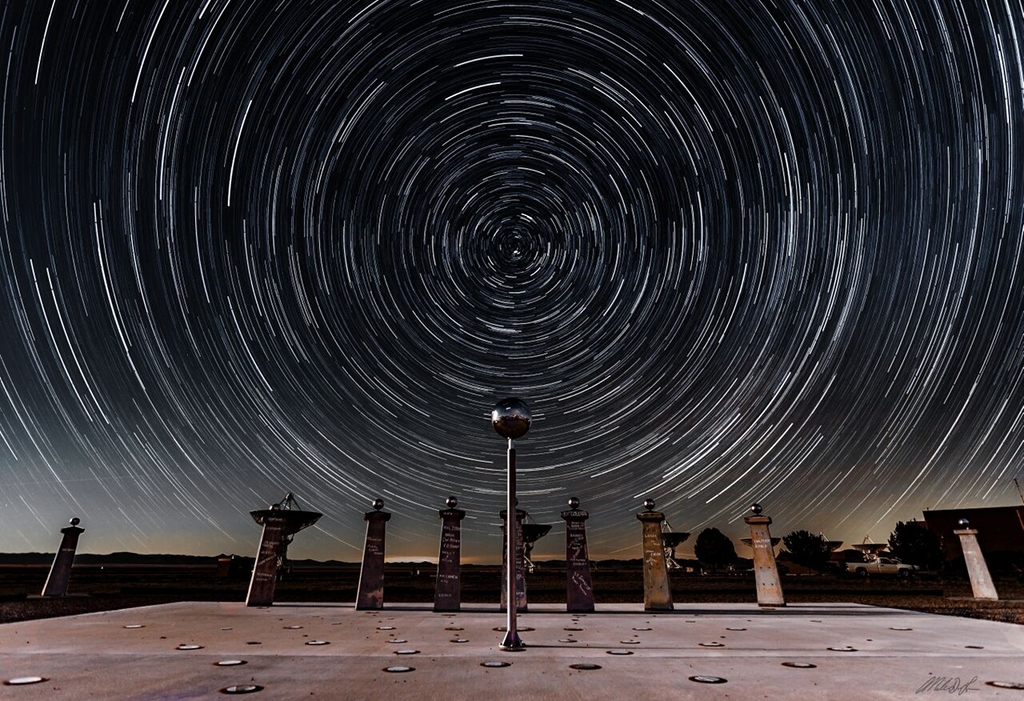
Image Credit & Copyright: Miles Lucas at NRAO
Explanation: Sundials use the location of a shadow to measure the Earth's rotation and indicate the time of day. So it's fitting that this sundial, at the Very Large Array Radio Telescope Observatory in New Mexico, commemorates the history of radio astronomy and radio astronomy pioneer Ronald Bracewell. The radio sundial was constructed using pieces of a solar mapping radio telescope array that Bracewell orginaly built near the Stanford University campus. Bracewell's array was used to contribute data to plan the first Moon landing, its pillars signed by visiting scientists and radio astronomers, including two Nobel prize winners. As for most sundials the shadow cast by the central gnomon follows markers that show the solar time of day, along with solstices and equinoxes. But markers on the radio sundial are also laid out according to local sidereal time. They show the position of the invisible radio shadows of three bright radio sources in Earth's sky, supernova remnant Cassiopeia A, active galaxy Cygnus A, and active galaxy Centaurus A. Sidereal time is just star time, the Earth's rotation as measured with the stars and distant galaxies. That rotation is reflected in this composited hour-long exposure. Above the Bracewell Radio Sundial, the stars trace concentric trails around the north celestial pole.
12/07/2018
CEDIC Team at Chilescope - Centaurus A - Astronomy picture of the day - 2018 July 12
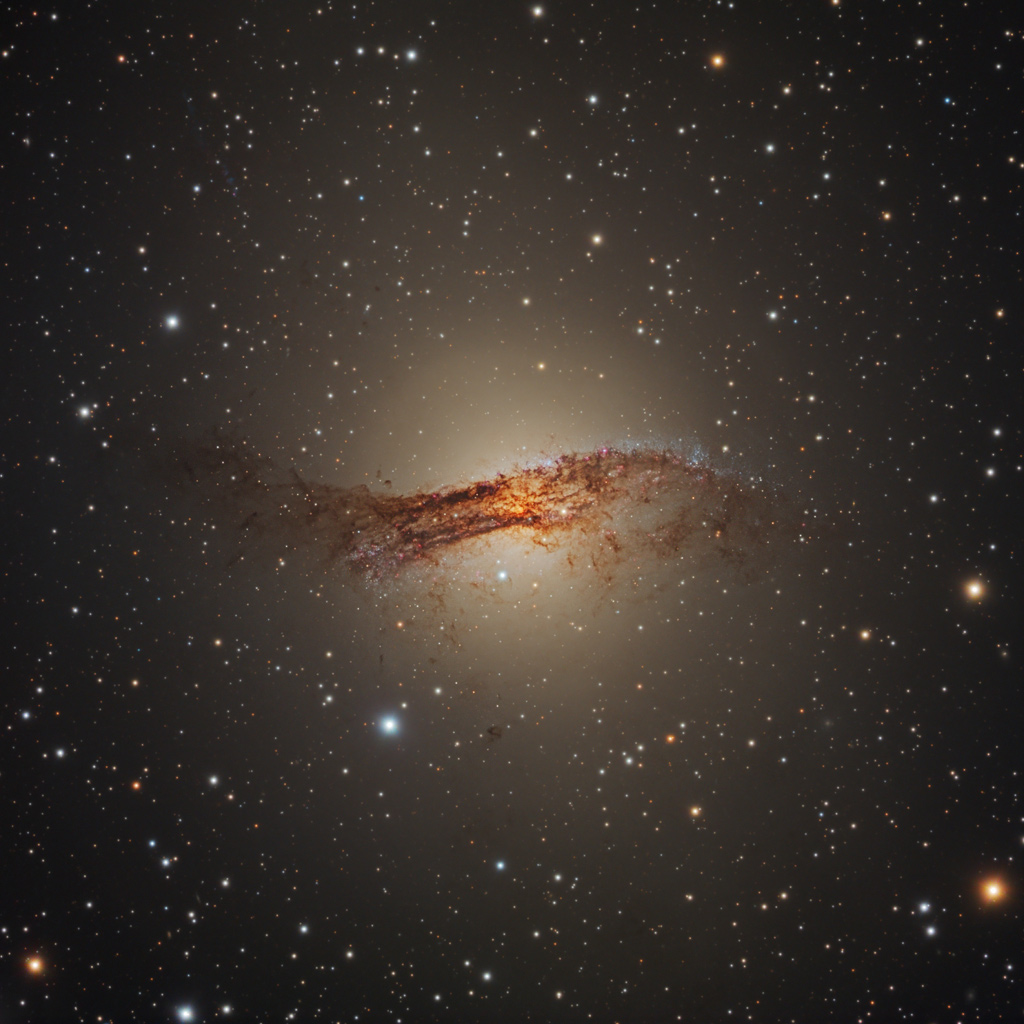
Image Credit & Copyright: CEDIC Team at Chilescope, Processing - Bernhard Hubl
Explanation: Only 11 million light-years away, Centaurus A is the closest active galaxy to planet Earth. Spanning over 60,000 light-years, the peculiar elliptical galaxy also known as NGC 5128, is featured in this sharp telescopic view.Centaurus A is apparently the result of a collision of two otherwise normal galaxies resulting in a fantastic jumble of star clusters and imposing dark dust lanes. Near the galaxy's center, left over cosmic debris is steadily being consumed by a central black hole with a billion times the mass of the Sun. As in other active galaxies, that process likely generates the radio, X-ray, and gamma-ray energy radiated by Centaurus A.
11/07/2018
Science et Vie - Ciel de juillet : une éclipse totale sous le signe de mars - Espace

Le 27 juillet 2018 restera dans les annales astronomiques comme la nuit où une éclipse totale de Lune a eu lieu au moment où Mars était au plus près de la Terre : un spectacle prodigieux, à ne manquer sous aucun prétexte.
Le ciel de juillet sera, comme ce mois de juin, dominé par les planètes : Vénus au couchant, puis Jupiter en début de soirée, enfin Saturne et Mars au cœur de la nuit... Une magnifique et brillante horlogerie cosmique, réglée par le tic-tac plus rapide de la Lune, qui croisera Vénus le 15 et le 16, Jupiter le 20, Saturne le 24 et enfin Mars... le 27 juillet.
Sauf que par un extraordinaire hasard du calendrier cosmique, cette nuit du 27 verra la Pleine Lune, totalement éclipsée, luire aux côtés de la planète Mars, qui brillera alors d'un éclat exceptionnel. En effet, Mars sera alors au plus près de la Terre, à seulement 57 millions de kilomètres, ce qui n'arrive que tous les quinze ans. La magnitude - c'est-à-dire l'éclat, dans le langage des astronomes - de Mars sera de -2.8, l'astre, véritable rubis céleste, brillera plus de dix fois plus que les brillantes étoiles qui l'environnent, comme Antarès, Altaïr, Arcturus, Véga ou Deneb.

Jean-Luc Dauvergne - Noctilucent Clouds over Paris Fireworks - Astronomy picture of the day - 2018 July 11
Video Credit & Copyright: Jean-Luc Dauvergne (Ciel et Espace);
Explanation: It's northern noctilucent cloud season -- perhaps a time to celebrate! Composed of small ice crystals forming only during specific conditions in the upper atmosphere, noctilucent clouds may become visible at sunset during late summer when illuminated by sunlight from below. Noctilucent clouds are the highest clouds known and now established to be polar mesospheric clouds observed from the ground. Although observed with NASA's AIM satellitesince 2007, much about noctilucent clouds remains unknown and so a topic of active research. The featured time-lapse video shows expansive and rippled noctilucent clouds wafting over Paris, France, during a post-sunset fireworks celebration on Bastille Day in 2009 July. This year, several locations are already reporting especially vivid displays of noctilucent clouds.
09/07/2018
John Chumack - Road to Mars - Astronomy picture of the day - 2018 July 9
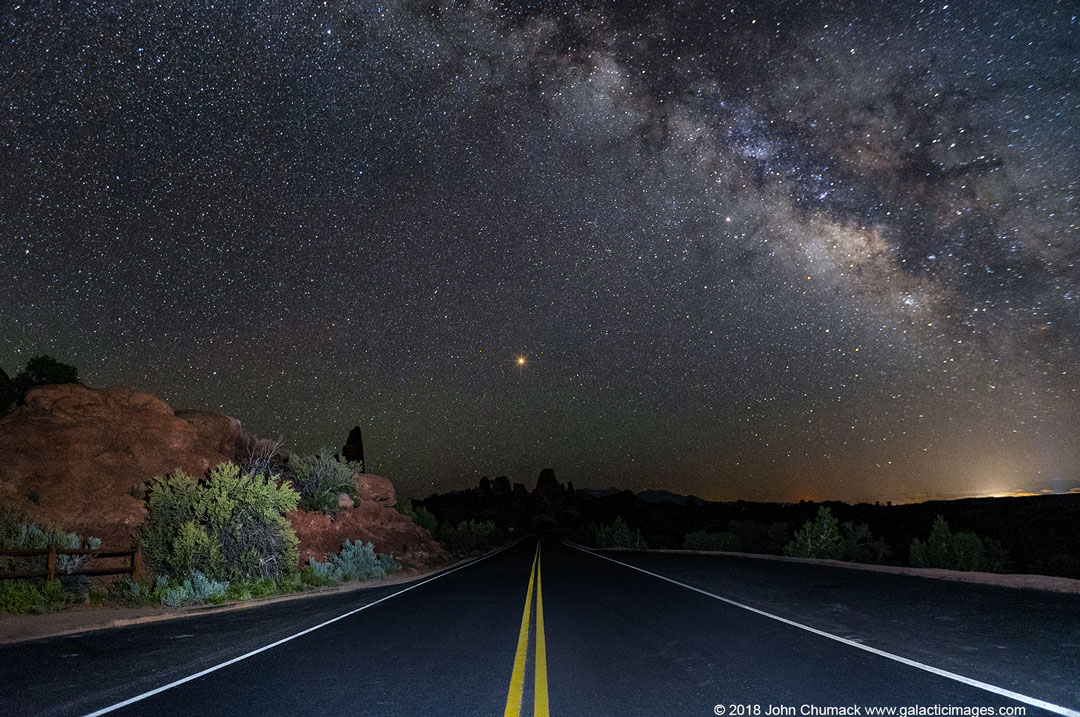
Image Credit & Copyright: John Chumack
Explanation: What's that light at the end of the road? Mars. This is a good month to point out Mars to your friends and family because our neighboring planet will not only be its brightest in 15 years, it will be visible for much of night.During this month, Mars will be about 180 degrees around from the Sun, and near the closest it ever gets to planet Earth. In terms of orbits, Mars is also nearing the closest point to the Sun in its elliptical orbit, just as Earth moves nearly between it and the Sun -- an alignment known as perihelic opposition. In terms of viewing, orange Mars will rise in the east just as the Sun sets in the west, on the opposite side of the sky. Mars will climb in the sky during the night, reach its highest near midnight, and then set in the west just as the Sun begins to rise in the east. The red planet was captured setting beyond a stretch of road in Arches National Park in mid-May near Moab, Utah, USA.
08/07/2018
Nasa : The Extraordinary Spiral in LL Pegasi - Astronomy picture of the day - 2018 July 8
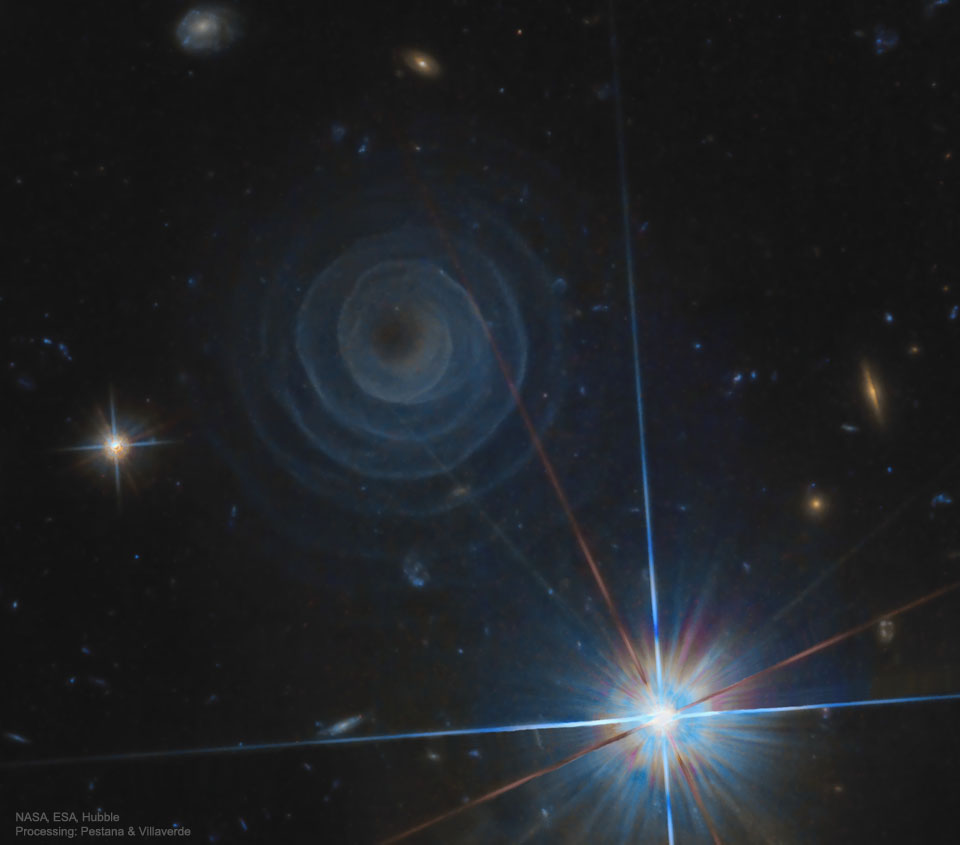
Image Credit: NASA, ESA, Hubble, HLA; Processing & Copyright: Domingo Pestana & Raul Villaverde
Explanation: What created the strange spiral structure on the upper left? No one is sure, although it is likely related to a star in a binary star system entering the planetary nebula phase, when its outer atmosphere is ejected. The huge spiral spans about a third of a light year across and, winding four or five complete turns, has a regularity that is without precedent. Given the expansion rate of the spiral gas, a new layer must appear about every 800 years, a close match to the time it takes for the two stars to orbit each other. The star system that created it is most commonly known as LL Pegasi, but also AFGL 3068. The unusual structure itself has been cataloged as IRAS 23166+1655. The featured image was taken in near-infrared light by the Hubble Space Telescope. Why the spiral glows is itself a mystery, with a leading hypothesis being illumination by light reflected from nearby stars.
07/07/2018
Ruslan Merzlyakov - A Northern Summer's Night - Astronomy picture of the day - 2018 July 7

Image Credit & License: Ruslan Merzlyakov (RMS Photography)
Explanation: Near a summer's midnight a mist haunts the river bank in this dreamlike skyscape taken on July 3rd from northern Denmark. Reddened light from the Sun a little below the horizon gives an eerie tint to low hanging clouds. Formed near the edge of space, the silvery apparitions above them are noctilucent or night shining clouds. The icy condensations on meteoric dust or volcanic ash are still in full sunlight at the extreme altitudes of the mesophere. Usually seen at high latitudes in summer months, wide spread displays of the noctilucent clouds are now being reported.
06/07/2018
Nasa - Charon: Moon of Pluto - Astronomy picture of the day - 2018 July 6
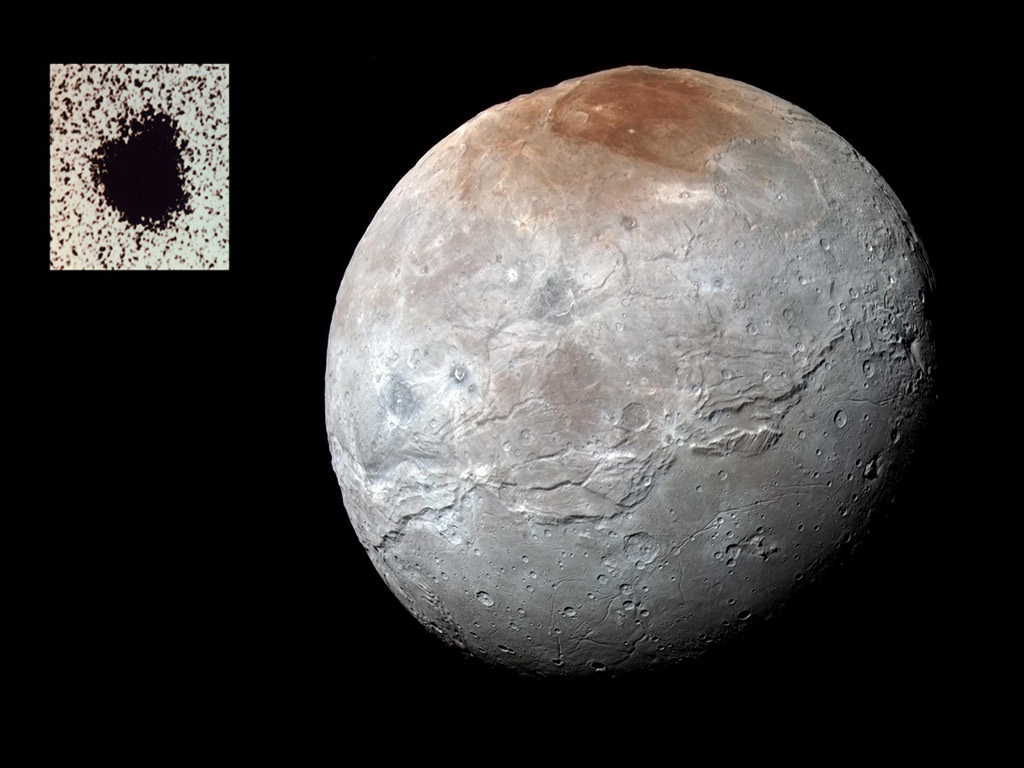
Image Credit: NASA, Johns Hopkins Univ./APL, Southwest Research Institute, U.S. Naval Observatory
Explanation: A darkened and mysterious north polar region known to some as Mordor Macula caps this premier high-resolution view. The portrait of Charon, Pluto's largest moon, was captured by New Horizons near the spacecraft's closest approach on July 14, 2015. The combined blue, red, and infrared data was processed to enhance colors and follow variations in Charon's surface properties with a resolution of about 2.9 kilometers (1.8 miles). A stunning image of Charon's Pluto-facing hemisphere, it also features a clear view of an apparently moon-girdling belt of fractures and canyons that seems to separate smooth southern plains from varied northern terrain. Charon is 1,214 kilometers (754 miles) across. That's about 1/10th the size of planet Earth but a whopping 1/2 the diameter of Pluto itself, and makes it the largest satellite relative to its parent body in the Solar System. Still, the moon appears as a small bump at about the 1 o'clock position on Pluto's disk in the grainy, negative,telescopic picture inset at upper left. That view was used by James Christy and Robert Harrington at the U.S. Naval Observatory in Flagstaff to discover Charon 40 years ago in June of 1978.
05/07/2018
Steve Cullen - Shadow Rise on the Inside Passage - Astronomy picture of the day - 2018 July 5

Image Credit & Copyright: Steve Cullen
Explanation: At sunset look east not west. As Earth's dark shadow rises from the eastern horizon, faint and subtle colors will appear opposite the setting Sun. This beautiful evening sea and skyscape records the reflective scene from a cruise on the well-traveled Alaskan Inside Passage in the Pacific Northwest. Along the horizon the fading sunset gives way to the the pinkish anti-twilight arch, more poetically known as the Belt of Venus. Often overlooked at sunset in favor of the brighter western horizon, the lovely arch is tinted by filtered sunlight backscattered in the dense atmosphere, hugging the planet's rising blue-grey shadow.
03/07/2018
Ji-Hoon Kim - An Airplane in Front of the Moon - Astronomy picture of the day - 2018 July 3
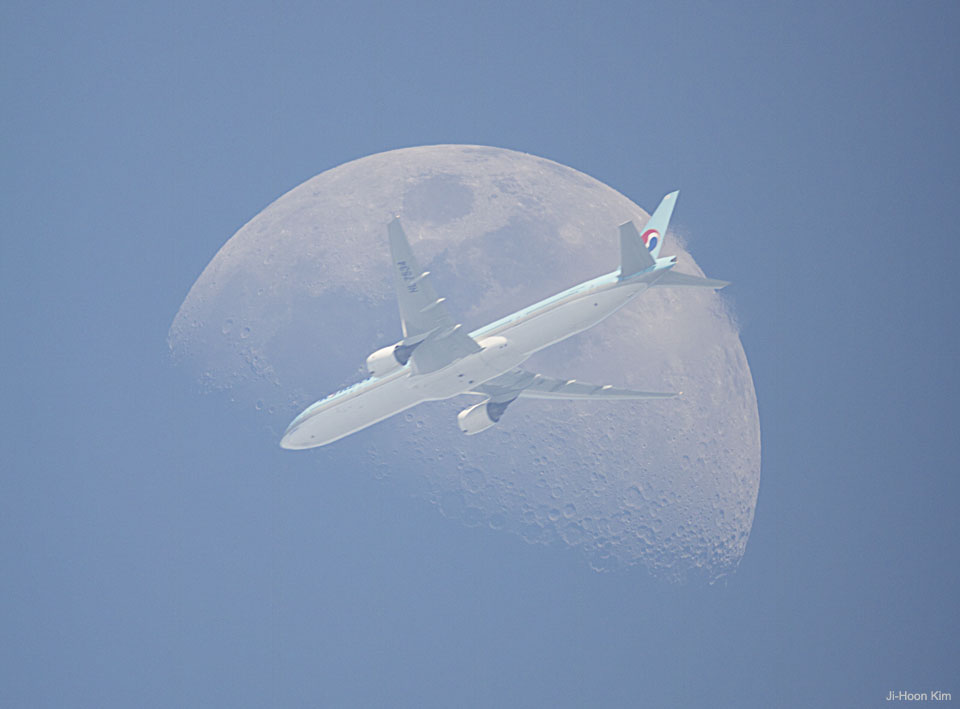
Image Credit & Copyright: Ji-Hoon Kim
Explanation: If you look closely at the Moon, you will see a large airplane in front of it. Well, not always. OK, hardly ever. Actually, to capture an image like this takes precise timing, an exposure fast enough to freeze the airplane and not overexpose the Moon -- but slow enough to see both, a steady camera, and luck -- because not every plane that approaches the Moon crosses in front. Helpful equipment includes a camera with fast continuous video mode and a mount that automatically tracks the Moon. The featured fleeting superposition was captured from Seoul, South Korea two weeks ago during a daytime waxing gibbous moonrise. Within 1/10th of a second, the airplane crossing was over.
01/07/2018
Fresh Tiger Stripes on Saturn's Enceladus - Astronomy picture of the day - 2018 July 1
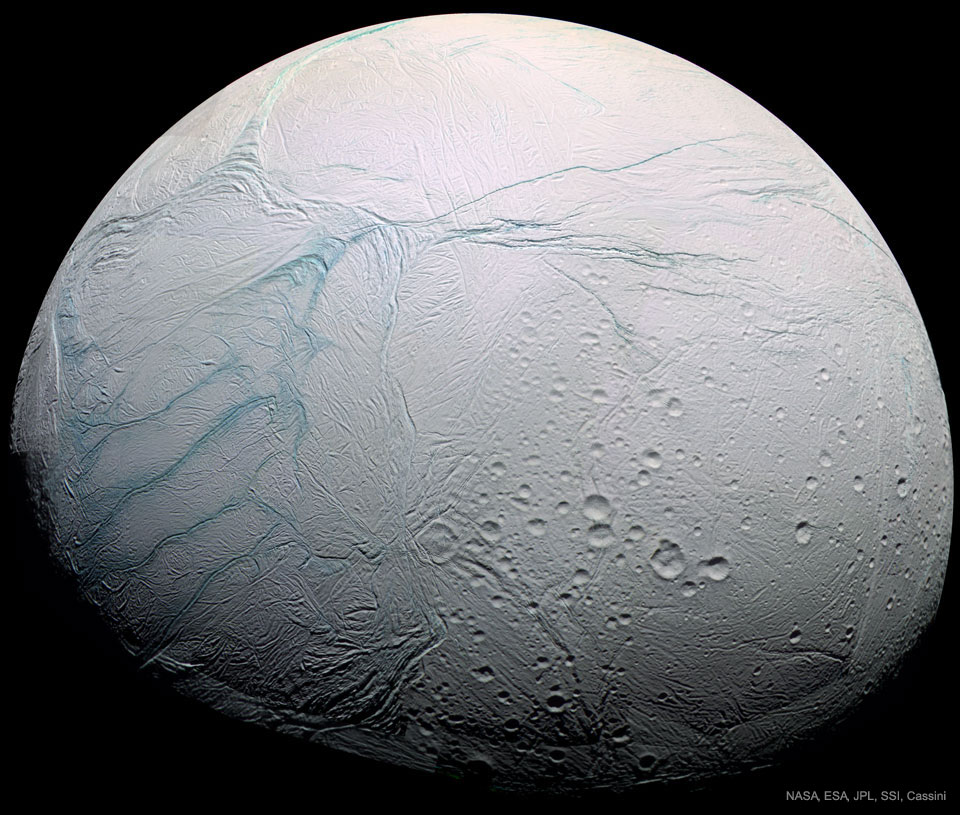
Image Credit: NASA, ESA, JPL, SSI, Cassini Imaging Team
Explanation: Do underground oceans vent through the tiger stripes on Saturn's moon Enceladus? Long features dubbed tiger stripes are known to be spewing ice from the moon's icy interior into space, creating a cloud of fine ice particles over the moon's South Pole and creating Saturn's mysterious E-ring. Evidence for this has come from the robot Cassini spacecraft that orbited Saturn from 2004 to 2017. Pictured here, a high resolution image of Enceladus is shown from a close flyby. The unusual surface features dubbed tiger stripes are visible in false-color blue. Why Enceladus is active remains a mystery, as the neighboring moon Mimas,approximately the same size, appears quite dead. Arecent analysis of ejected ice grains has yielded evidence that complex organic molecules exist inside Enceladus. These large carbon-rich molecules bolster -- but do not prove -- that oceans under Enceladus' surface could contain life.
Inscription à :
Commentaires (Atom)
ASTRONOMY - Juno Flyby of Ganymede and Jupiter
2025 December 14 Juno Flyby of Ganymede and Jupiter Video Credit: NASA , JPL-Caltech , SWRI , MSSS ; Animation: Koji Kuramura , Geral...

-
2022 September 26 All the Water on Planet Earth Illustration Credit: Jack Cook, Adam Nieman, Woods Hole Oceanographic Institution ; Data ...
-
2025 May 11 The Surface of Venus from Venera 14 Image Credit: Soviet Planetary Exploration Program , Venera 14 ; Processing & Copyri...